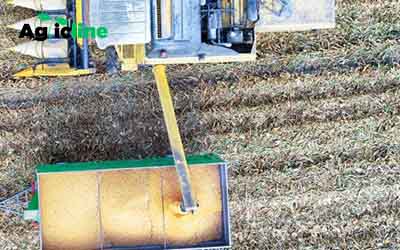A hay accumulator is a piece of equipment used in hay harvesting operations to collect and accumulate baled hay into a compact and organized unit. It is typically attached to a hay baler and works in conjunction with it to streamline the baling process and improve efficiency.
Hay accumulators come in various configurations and can be attached to different types of hay balers, such as round balers or square balers. They are designed to be durable, reliable, and adaptable to different field conditions.
The specific features and capabilities may vary depending on the manufacturer and model of the hay accumulator.
Overall, a hay accumulator is a valuable tool in hay harvesting operations, offering increased efficiency, labor savings, improved hay quality, and enhanced transport and storage capabilities.
It streamlines the baling process, reduces manual labor requirements, and contributes to the overall productivity and profitability of hay production operations.

Hay accumulator functions
See below;
Collection of Baled Hay
The primary function of a hay accumulator is to collect the baled hay as it is discharged from the baler. Instead of dropping the bales individually onto the ground, the accumulator gathers them in a sequential manner, creating a neat and organized stack.
This eliminates the need for manual bale handling, reduces labor requirements, and improves overall productivity.
Formation of Hay Packs
As the hay accumulator collects the bales, it arranges them into packs or groups of multiple bales. The specific pack size can be adjusted according to the desired configuration, such as packs of 5, 8, or 10 bales. This pack formation simplifies subsequent handling, transportation, and storage of the hay.
Efficient Field Operations
By incorporating a hay accumulator into the baling process, field operations can be carried out more efficiently.
The operator can focus on operating the baler without the need to continuously stop and manually handle each bale. This streamlines the baling process, reduces downtime, and increases overall field productivity.
Reduced Labor Requirements
The use of a hay accumulator significantly reduces the need for manual labor in the baling process.
As the bales are automatically collected and arranged into packs, there is no longer a requirement for workers to manually lift, stack, or transport individual bales. This not only saves time but also minimizes physical strain on workers and improves overall safety.
Improved Hay Quality
By minimizing manual handling and reducing bale contact with the ground, a hay accumulator helps preserve the quality of the harvested hay.
It reduces the risk of contamination, such as dirt, moisture, or foreign objects, which can impact the nutritional value and marketability of the forage. Additionally, the organized and compact pack formation aids in maintaining bale integrity during storage and transportation.
Increased Efficiency in Transport and Storage
Hay accumulators create uniform and well-organized packs of bales, facilitating more efficient transportation and storage.
Features of Hay Accumulator
Hay accumulators come with various features that enhance their functionality and efficiency in the hay harvesting process.
- Adjustable Bale Sizes: Many hay accumulators allow operators to adjust the size of the bale packs they form. This feature enables customization based on specific requirements, such as creating packs of 5, 8, or 10 bales, depending on the desired configuration and subsequent handling needs.
- Hydraulic System: Hay accumulators are typically equipped with a hydraulic system that powers the accumulation and pack formation process. Hydraulic cylinders control the movement of the bale collector and pack formation components, ensuring smooth operation and precise control.
- Bale Alignment Guides: To ensure accurate alignment and formation of bale packs, hay accumulators often include guides or rails that guide the bales into proper positions. These guides help maintain the desired pack shape and prevent bale misalignment.
- Bale Retention Mechanisms: Hay accumulators feature mechanisms to secure the bales within the pack, preventing them from shifting or becoming dislodged during handling and transportation. This ensures that the bales remain tightly packed and maintain their integrity.
- Safety Features: Safety is an important aspect of hay accumulator design. Many models include safety features such as emergency stop buttons or quick-release mechanisms to halt the operation in case of any issues or hazards. These features protect both the operator and the equipment.
- Durability and Construction: Hay accumulators are built to withstand the demanding conditions of hay harvesting. They are typically constructed from robust materials such as heavy-duty steel or high-strength alloys to ensure durability and longevity. The components are designed to handle the weight and impact of bales during the accumulation process.
- Compatibility and Easy Attachment: Hay accumulators are designed to be compatible with different types and brands of hay balers. They often feature a universal mounting system or attachment points that allow for easy and quick connection to the baler. This compatibility enhances versatility and ease of use across various equipment configurations.
- Operator Controls: Hay accumulators may have user-friendly controls accessible to the operator. These controls allow for adjustments, such as bale size, pack formation, or speed, providing operators with flexibility and customization options.
- Maneuverability and Transportability: Some hay accumulators are designed with features that facilitate transportability between fields or farms. These may include folding mechanisms or quick-detach systems that make it easier to move or transport the equipment when not in use.
- Maintenance and Serviceability: Manufacturers often design hay accumulators with maintenance and serviceability in mind. Accessible components, convenient lubrication points, and clear maintenance instructions contribute to the ease of servicing and upkeep of the equipment.
Maintenance of Hay Accumulator
Proper maintenance of a hay accumulator is essential to ensure its reliable performance, longevity, and safety. Regular maintenance practices can help identify and address any issues promptly, prevent breakdowns, and maximize the efficiency of the equipment.
Here are some key maintenance tasks for a hay accumulator:
- Clean the hay accumulator after each use to remove debris, dust, and hay remnants. Pay particular attention to the bale collection and pack formation areas, as well as the hydraulic components. Use compressed air, brushes, or water (if appropriate) to remove buildup and maintain optimal functionality.
- Follow the manufacturer’s guidelines for lubrication points and intervals. Apply lubricants to moving parts such as pivot points, hinges, and bearings to reduce friction and ensure smooth operation. Use the recommended type and quantity of lubricants for each component.
- Conduct regular inspections of the hay accumulator to identify any signs of wear, damage, or potential issues. Check the hydraulic hoses, cylinders, bolts, and welds for integrity. Inspect the bale alignment guides, retention mechanisms, and safety features to ensure they are functioning properly.
- Inspect the hydraulic system for leaks, damaged hoses, or worn-out seals. Address any issues promptly to prevent hydraulic fluid leaks and maintain proper pressure and control. Regularly check the hydraulic fluid level and quality, and follow the manufacturer’s recommendations for fluid replacement.
- Inspect the bale retention mechanisms, such as pins, latches, or locks, to ensure they are secure and functioning correctly. Replace any damaged or worn-out components to maintain reliable bale retention within the pack.
- Regularly check the frame, brackets, and structural components of the hay accumulator for any signs of damage, cracks, or fatigue. Repair or reinforce any weakened or damaged sections to ensure the equipment’s stability and longevity.
- Inspect and tighten all fasteners, bolts, and nuts regularly. Vibration during operation can cause them to loosen over time, potentially leading to equipment malfunction or safety hazards.
- If the hay accumulator has an electrical system, such as control panels or sensors, inspect the wiring, connectors, and electrical components. Ensure that all connections are secure and free from damage or corrosion.
- Regularly train operators on the proper operation and safety procedures specific to the hay accumulator. Emphasize the importance of safe handling, appropriate use of controls, and adherence to manufacturer guidelines. Encourage operators to report any issues or concerns related to the equipment promptly.
- When not in use, store the hay accumulator in a clean, dry, and protected environment. Shield it from exposure to harsh weather conditions, sunlight, and moisture to prevent corrosion, rust, or deterioration.



